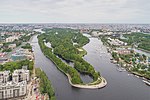All-Russian Scientific Research and Design Institute of Energy Technology
All-Russian Scientific Research And Design Institute Of Energy Technology (VNIPIET) (Russian: Головной институт «ВНИПИЭТ») is a research institute in Saint Petersburg, Russia. VNIPIET prepares designs and project documentation for the construction, reconstruction, and technical refurbishment of atomic power stations. It is associated with many major projects in this field, including design of the containment sarcophagus for the damaged reactor at Chernobyl. It also does design work for radiochemical, metallurgical, mechanical, and instrument-engineering plants and performs research work on decontamination and removal of radioactive contamination and transportation of radioactive waste.
Excerpt from the Wikipedia article All-Russian Scientific Research and Design Institute of Energy Technology (License: CC BY-SA 3.0, Authors).All-Russian Scientific Research and Design Institute of Energy Technology
улица Савушкина, Saint Petersburg Novaya Derevnya (округ Ланское)
Geographical coordinates (GPS) Address Nearby Places Show on map
Geographical coordinates (GPS)
| Latitude | Longitude |
|---|---|
| N 59.98355 ° | E 30.2651 ° |
Address
улица Савушкина 82
197183 Saint Petersburg, Novaya Derevnya (округ Ланское)
Saint Petersburg, Russia
Open on Google Maps











